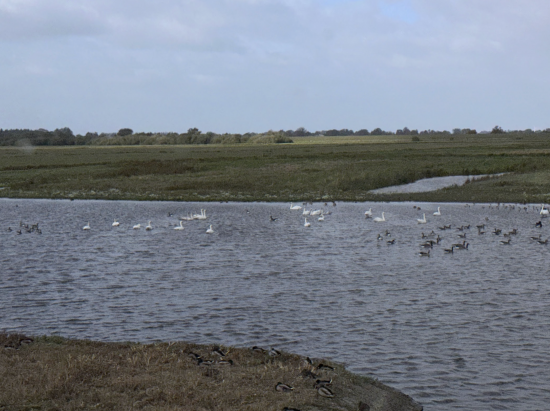I was at Welney this morning, the Norfolk bird reserve about five miles north of Ely, where large numbers of Whooper swans overwinter every year. They began returning from Iceland, where they breed, last week, and whilst we were there, nineteen more adults with fourteen cygnets turned up, almost certainly having made the 1,200-kilometre nonstop flight overnight.
Nighttime flying works for the swans. It is thought that they lose less heat and that the air is less dense, making it easier for them to make progress.
I find this a staggering achievement, and for the cygents, this will, of course, have been a first such trip. They could make many more over the years to come. The average life expectancy of this swan is about nine years, although some live much longer. How they navigate so precisely is amazing. How they do this with no physical preparation is astonishing, and yet, like many geese, that is precisely what they are designed to do.
I just watched them in quiet awe. This is not a good photo, but it shows some of those new migrants. The wind had not encouraged me to take anything better than my phone this morning. But I thought this was worth sharing.
It is for moments like these that I enjoy birdwatching, and that is why visiting the same place often is so rewarding. Every day is different.

Thanks for reading this post.
You can share this post on social media of your choice by clicking these icons:
There are links to this blog's glossary in the above post that explain technical terms used in it. Follow them for more explanations.
You can subscribe to this blog's daily email here.
And if you would like to support this blog you can, here:


 Buy me a coffee!
Buy me a coffee!

1200 miles non-stop – absolutely incredible!
Incredible indeed….and if you then go on to acknowledge the Arctic Tern’s 44,000 mile ‘commute’ we should all of us feel humbled and in awe.
I love arctic terns. How on earth did they come up with that routine?
In one night! Say 15 hours, that’s 80 miles per hour.
The time varties with the wind. 12 to 24 hours can be involved. The timing means it is more during the night than day. Still pretty amamzing.
In 24 hours even, and that’s a stretch as it’s unlikely to have been that long, that’s still an average of 50 miles per hour!
Agreed. Amazing.
Don’t tell Badenoch about these new migrants, she’ll be wanting to deport them.
I chose my words wisely.
I think the swans deport themselves…..
Most do. Some stay, mainly the injured ones.
That is apposite given that the swans might just be tempted by the benefits. Just might.
https://www.wwt.org.uk/wetland-centres/welney/whats-on/events/swan-feed-330pm
🙂
There is a theory which involves the movement of tectonic plates over millions of years for some migratory species like the arctic tern. Ie. the terns kept following the plentiful food in the arctic summer but the land literally moved.
Probably true. The desertification of the Sahara has almost certainly affected those species which migrate across or around it. It wasn’t always as large as it is now, it’s expanded rapidly on a geological timescale.
Moments like these make life feel _really_ worth living. I am surrounded by SSSIs and whenever I see birds arriving to over-winter, or just passing through, I often think how these birds’ ancestors touched down on these same waters, long before the dawn of human history. Their descendants will still be arriving long after we have brought human history to an end.
Agreed
Some might regard this as a quibble but in this day and age (culture wars, denial of science, etc) I don’t.
“…that is precisely what they are designed to do.”. I have to strongly disagree. That statement implies a designer – for which there is no proof. The correct thing to say would have been “…that is what they have evolved to do”.
It annoys me too when the likes of Chris Packham refer to events in nature as “miracles” when no-one has ever produced any evidence of such an occurrence.
Rant over.
That aside, I really do admire the work you are producing.
Noted, but I still think it miraculous and a source for wonder.
I wonder whether Kemi asks her parents why don’t they go back to where they came from?
That reminds me. I must pop into RSPB Saltholme – it’s just a fifteen minute drive from where I live.
You won’t regret it